
* Aleksandr Sergeyevich Yakovlev began his career as an aircraft designer for the Soviet state in the 1920s, ultimately developing a wide range of civil and military aircraft. Among his designs were a number of twin-piston trainers, bombers and transports, none of which were produced in large quantity. This document provides a history and description of Yak twin-piston aircraft.
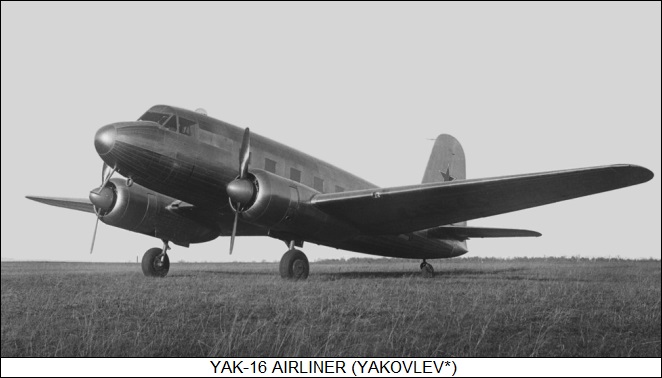
* In the 1920s, Aleksandr Yakovlev was an aircraft mechanic, attending the Red Air Force Academy (VVA). He constructed a series of prototype aircraft, mostly for the OSOAVIAKhIM, the Soviet civil aviation society. The first was a two-seater biplane, the "AIR-1", where "AIR" stood for Alexei Ivanovich Rykov, head of the OSOAVIAKhIM. Further AIR designs followed, leading up to development of the "UT-1" and "UT-2" single-engine trainers for the Red Air Force (VVS in its Russian acronym), discussed elsewhere.
By the late 1930s Yakovlev had his own experimental design bureau (OKB), and was ready to move on to twin-engine aircraft. The first was a bomber trainer, originally designated "AIR-17", but more simply known as "Samolyot (Aircraft) 17 (S-17)" or "Ya-17" when it was rolled out in the spring of 1938 -- Rykov had been arrested and was officially a "nonperson", so the "AIR" designation was no longer fashionable.
The S-17 prototype was a low-wing monoplane with twin engines and tailwheel landing gear. It was of mixed construction, with steel, aluminum alloy, and wood structural elements; plus skinning of aluminum alloy, plywood, and fabric. It was powered by two French Renault 6Q-01 Bengali inverted-inline air-cooled engines providing 164 kW (220 HP) each, driving two-bladed variable-pitch metal propellers. The production machines were to be powered by license-built Soviet MV-6 equivalents. Fuel tanks were in the wing roots.
All landing gear assemblies featured single wheels, the castoring tailwheel being fixed, the main gear retracting back into the engine nacelles. Ski landing gear could also be fitted, though the gear couldn't be retracted in that case. There were three crew, including pilot, gunner-radio operator in a rear cockpit, and navigator-bombardier sitting in the glazed nose. The navigator-bombardier had auxiliary flight controls to allow him to fly the aircraft to spell the pilot. Although the prototype was unarmed, production machines were to have a ShKAS 7.62-millimeter machine gun on a flexible mount in the nose and rear positions. The aircraft had a bomb bay, allowing it to carry of six 50-kilogram (110-pound) bombs or three 100-kilogram (220-pound) bombs.
___________________________________________________________________
YAKOVLEV S-17 / UT-3:
___________________________________________________________________
wingspan:
15 meters (49 feet 2 inches)
wing area:
33.42 sq_meters (360 sq_feet)
length:
10.7 meters (35 feet 1 inch)
empty weight:
2,040 kilograms (4,500 pounds)
MTO weight:
2,900 kilograms (6,390 pounds)
max speed at altitude:
275 KPH (170 MPH / 150 KT)
service ceiling:
4,000 meters (13,125 feet)
range:
1,000 kilometers (620 MI / 540 NMI)
___________________________________________________________________
Early flight trials indicated some need for fixes, one being that the wings should be more easily detached to simplify storage and transport. Following tweaks to the design, by late 1938 the aircraft was approved for production as the "UT-3", with work begun at Plant Number 81 in Moscow on an initial batch of ten machines.
At this point, the exercise began to collapse in on itself. The first production machines were delivered in late 1939, with evaluations showing that the weight gain accumulated through fixes had caused the aircraft's performance and handling to deteriorate to an unacceptable level -- not only was it too heavy, the center of gravity had migrated to the rear, making the aircraft inclined to go into a flat spin.
Plans for series manufacture were put on hold. Work was conducted on a second batch of UT-3 machines with substantial changes at Plant Number 47 in Leningrad, with changes including fixed instead of retractable landing gear, no rear cockpit, and no nose glazing -- the UT-3 had become a twin-engine trainer, with seating only for a trainee and flight instructor. Performance actually improved despite the fixed landing gear, mostly because the weight of the aircraft had been reduced substantially.
Trials conducted in the spring of 1941 led to approval for production of the UT-3 in its new form, but only a few were built before the German invasion on 22 June 1941. With drastically altered priorities, the UT-3 program evaporated and would not be revived.
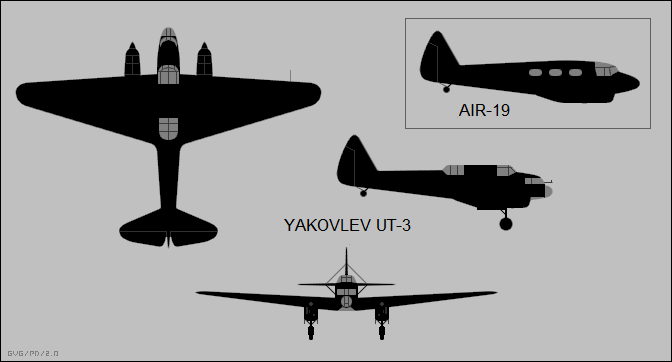
* In parallel with development of the S-17 / UT-3, the Yak OKB also worked on a utility aircraft, the "S-19" (or "Ya-19", originally the "AIR-19"), which was essentially a UT-3 with a different fuselage, with seating for five passengers, access being through a door at the left rear fuselage. A single prototype was rolled out in 1938, being put through its paces by the Yak bureau and then submitted for state trials in the fall of 1939. The aircraft proved satisfactory in state trials and there were plans to go to production, with an air ambulance variant mocked up as well. However, the S-19 was dependent on production of the UT-3, and when the UT-3 was canceled, the S-19 went down with it.
BACK_TO_TOP* While the Yak OKB was trying to get the UT-3 through its paces, Yakovlev was also working under his own initiative on a fast twin-engine combat aircraft, with the "Ya-22" unarmed demonstrator performing its initial flights in the spring of 1939. It was a low-wing monoplane of mixed construction, with a twin-fin tail and retractable tricycle landing gear, powered by twin Klimov M-103 vee-12 liquid-cooled engines with 695 kW (930 HP) each and driving three-bladed variable-pitch props. It had a pilot forward and a navigator in a rear cockpit, with glazing over the rear position.
Performance was excellent, with the demonstrator attaining 560 KPH (348 MPH) early on in trials. VVS officers who observed the flights were suitably impressed, and brought it to the attention of Soviet dictator Josef Stalin. Stalin was intrigued, finding the Ya-22 promising; the aircraft performed a public flypast during the May Day celebrations in Moscow that year, and going into state trials at the end of that month. Trials confirmed the Ya-22's high performance, though there were difficulties with engine overheating, the fuel system, and landing gear brakes.
Development went forward on a light bomber version, designated the "blizhniy bombardirovshchik model 22 (BB-22)". It was to feature defensive armament of a single flexibly-mounted 7.62-millimeter ShKAS machine gun, with the navigator to serve as gunner, the two aircrew sitting back-to-back in a greenhouse-style canopy -- a combined cockpit being seen as better for crew communications. It would be able to carry up to 700 kilograms (1,545 pounds) of bombs in an internal bomb bay and on external racks.
A preliminary production batch of ten aircraft was turned out and evaluated in early 1940. The evaluation gave the type a thumb's down. The BB-22 had been essentially a high-speed demonstrator, and adding the required combat kit effectively ate up the aircraft's performance; handling was also affected for the worse, and production quality left something to be desired as well. Overall, the BB-22 was by no means superior to the Tupolev SB twin-engine bomber in VVS service, and the SB was clearly on the edge of obsolescence.
Yak OKB engineers went to work on fixing the problems, incorporating many changes, most notably twin-wheel main landing gear and the rear fuselage cut down to give the back-seater a better view to the "6:00" position. Performance as well as manufacturing quality were improved, though the defensive armament was too light and handling still left something to be desired. It was nonetheless approved for production in November 1940 as the "Yak-2".
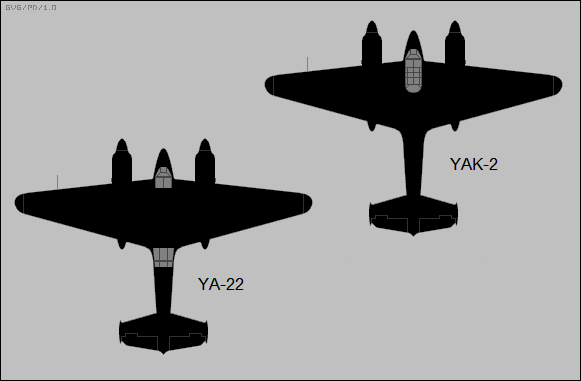
Along with the basic bomber variant, several other Yak-2 configurations were evaluated:
The additional power provided by the M-105 seemed like it might do the Yak-2 some good, so the Yak-2 was appropriately re-engined, also with a fair set of airframe tweaks, the modified machine being known as the "BB-22bis", where "bis" is Latin / French for "encore", translating in this context as "plus". Evaluation being positive, it was put into production in late 1940 as the "Yak-4".
___________________________________________________________________
YAKOVLEV YAK-4:
___________________________________________________________________
wingspan:
14 meters (45 feet 11 inches)
wing area:
29.4 sq_meters (316 sq_feet)
length:
10.18 meters (33 feet 5 inches)
empty weight:
4,560 kilograms (10,050 pounds)
MTO weight:
6,115 kilograms (13,480 pounds)
max speed at altitude:
535 KPH (330 MPH / 290 KT)
service ceiling:
9,700 meters (31,825 feet)
range:
925 kilometers (575 MI / 500 NMI)
___________________________________________________________________
Roughly 200 Yak-2 and Yak-4 bombers were in service when the Germans invaded the USSR. They didn't do well in combat, partly because of the inexperience of their aircrews, and one way or another the type was out of service by the end of 1941.
BACK_TO_TOP* Although the German invasion in the summer of 1941 had forced the USSR to focus on construction of essential combat aircraft, it turned out that a capable utility aircraft was one of the essentials -- machines such as the Polikarpov U-2 biplane and the Yak UT-2 trainer being too limited for the job of delivering vital supplies and equipment to frontline airfields. In April 1942, the Yak OKB was tasked to develop a more suitable utility aircraft, making maximum use of available aircraft technology and materials. The two prototypes of the "Yak-6" were in the air by June 1942, an impressive accomplishment even given the admirable simplicity of the aircraft. The Yak-6 was put through its paces in state trials and was approved for production.
The Yak-6 was a tidy, pedestrian aircraft of conventional arrangement, with a low wing, twin engines, and retractable landing gear. Flight controls were conventional -- a single flap under the wing center section, ailerons, elevators, rudder -- and manually controlled. It was of highly mixed construction, with some use of steel framing but more heavily dependent on wood, plywood, and fabric. The fuel tanks were actually made from plastic-impregnated plywood! It was powered by twin Shvetsov M-11F five-cylinder air-cooled radial engines with 105 kW (140 HP) each, driving two-bladed fixed wooden propellers. One prototype featured prop spinners and engine cylinder fairings, but that wasn't production spec.
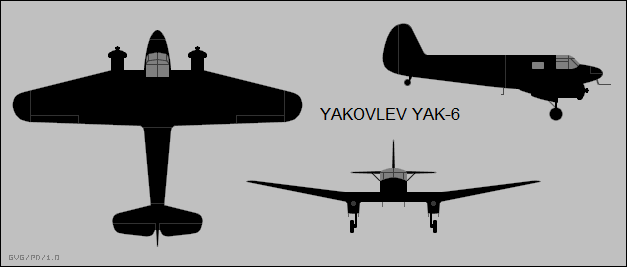
The Yak-6 had taildragger landing gear, all gear assemblies having single wheels, the tailwheel being fixed and the main gear retracting back into the engine nacelles, stowed with a hand crank. The initial prototype had fixed landing gear; late production machines would also have fixed landing gear. Subassemblies were borrowed wholesale from various production aircraft -- for example, the engine installation was taken very directly from the Yak UT-2 trainer.
___________________________________________________________________
YAKOVLEV YAK-6:
___________________________________________________________________
wingspan:
14 meters (45 feet 11 inches)
wing area:
29.6 sq_meters (319 sq_feet)
length:
10.35 meters (34 feet)
empty weight:
1,415 kilograms (3,120 pounds)
MTO weight:
2,300 kilograms (5,070 pounds)
max speed at altitude:
185 KPH (115 MPH / 100 KT)
service ceiling:
3,380 meters (11,090 feet)
range:
900 kilometers (560 MI / 485 NMI)
___________________________________________________________________
Along with pilot and navigator -- it is unclear if the Yak-6 had dual controls -- four passengers or 500 kilograms (1,100 pounds) of cargo could be hauled. The Yak-6 could also be configured as a short-range night bomber -- "nochnoy blizhniy bombardirovshchik (NBB)" -- carrying up to five 100-kilogram (220-pound) or two 250-kilogram (550-pound) bombs externally under the wing center section. The night bomber configuration also featured a ShKAS 7.62-millimeter machine gun on a rearward-facing flexible mount behind the cockpit for rear protection, being fired by the navigator standing up through a hatch; the exhausts were fitted with flame suppressors.
The Yak-6 was in production by the fall of 1943, with three plants ultimately building the aircraft. It was a sturdy and reliable machine, easy to fly, with aircrews calling it the "Dooglasyonok" -- "Baby Douglas", a reference to the US Douglas C-47 / DC-3 transport, common and popular in Soviet service. However, by the summer of 1943 doubts were accumulating about the Yak-6, thanks to a series of crashes. While generally benign to fly, it had some quirks in handling, particularly when overloaded. It seems likely the problems could have been corrected, but Yakovlev felt he had better things to work on, and the decision was made to focus on the roughly comparable Shcherbakov Shche-2 twin-engine light transport instead, Yak-6 production being halted. Over 380 had been built to that time. They remained in service to the end of the conflict, with tales that some of them were fitted with rocket launch rails and used as attack aircraft.
* The Yak OKB was not quite done with the Yak-6 design, however, with a team under Oleg Antonov -- who would later acquire his own OKB -- developing an improved derivative, the "Yak-8". It was effectively a Yak-6 with refinements and a more capacious fuselage, capable of hauling six passengers instead of four. It was supposed to be powered by twin Kossov M-12 radials, providing 140 kW (190 HP) each, but that engine being still in development, the two prototypes were powered by M-11FM radials, only marginally more powerful than the M-11F engines of the Yak-6.
The first prototype took to the air in early 1944. The prototypes, although underpowered, passed state acceptance trials, with the type being approved for production. It didn't happen; the Soviets had generally outgrown mixed-construction aircraft by that time, preferring all-metal aircraft, and the Yak-8 was too far behind the times.
BACK_TO_TOP* Following the end of World War II, the Soviet Union began to invest some resources into civil aviation. One initiative focused on the development of what would be now called a "regional airliner", with light passenger capacity and relatively short range, for regional flight routes where a larger airliner would be uneconomical to operate. In early 1946, the Yak OKB was tasked with developing a ten-seat, twin-piston airliner. Two prototypes were to be built, one in a civil airliner configuration, the other in a military configuration with defensive armament. The first prototype of the "Yak-16", as it was designated, performed its first flight on 24 September 1947, with Fyodor Abramov at the controls.
As it emerged, the Yak-16 was along the lines of a scaled-down Douglas DC-3. It could hardly be called a copy of the DC-3; it was just that the DC-3 had been such a pioneering design for a twin-piston airliner that it was hard to make such a thing that didn't look like it. The Yak-16 was a low-wing aircraft of all-metal construction, except for some fabric-covered flight surfaces, with taildragger landing gear. It was powered by twin Shvetsov ASh-21 seven-cylinder air-cooled radials providing 425 kW (570 HP) each, and driving two-blade variable-pitch propellers.
The wings had two spars, with tapered outer panels featuring a dihedral. Flight control surfaces were conventional, featuring flaps, ailerons, elevators, and rudder, all manually-controlled. All landing gear assemblies had single wheels, the tailwheel being nonretractable, the main gear retracting forward into the engine nacelles. The mainwheels were left semi-exposed after retraction, a very DC-3-like feature, which had the benefit of providing a bit of protection in wheels-up landings. There were two aircrew with dual controls, and ten passenger seats in five rows; there was an entry door on the left rear fuselage, with a baggage door on the right rear fuselage. A toilet was standard.
___________________________________________________________________
YAKOVLEV YAK-16 AIRLINER:
___________________________________________________________________
wingspan:
21.5 meters (70 feet 6 inches)
wing area:
56.25 sq_meters (605 sq_feet)
length:
15.6 meters (51 feet 2 inches)
height:
4.66 meters (15 feet 4 inches)
empty weight:
4,486 kilograms (9,982 pounds)
MTO weight:
6,021 kilograms (13,274 pounds)
max speed at altitude:
370 KPH (230 MPH / 200 KT)
service ceiling:
7,750 meters (25,430 feet)
range:
800 kilometers (500 MI / 430 NMI)
___________________________________________________________________
The militarized prototype performed its initial flight in the spring of 1948. The configuration was generally the same as for the civil version, except for:
The military variant could haul ten fully equipped troops, seven paratroops, or six stretchers and a medical attendant. Trials demonstrated that the two aircraft met specification and were easy to fly, with good engine-out handling. However, the Il-16 was not approved for production, the Antonov An-2 utility biplane being judged, in hindsight rightly, as more flexible and useful, if certainly not as elegant. The airliner prototype of the Il-16 was retained by the Yak OKB as a personnel transport.
* The very last Yak piston twin to be developed arose from a 1951 VVS requirement for a multi-engine / navigation trainer, with the design originally known as the "Yak-UBT". The first prototype, designated the "Yak-200", performed its initial flight on 10 April 1953, with Abramov at the controls.
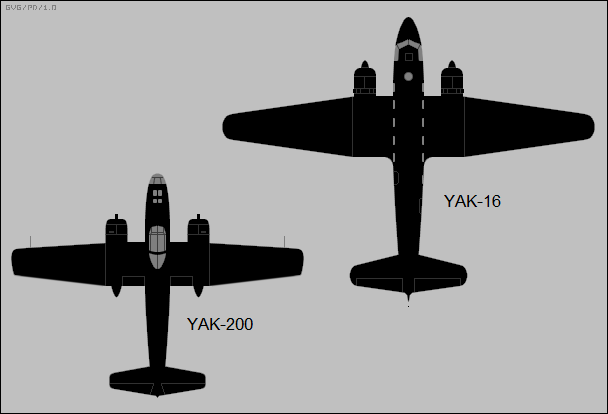
The Yak-200 was a tidy mid-wing aircraft, of all-metal construction except for some fabric-covered control surfaces, and retractable tricycle landing gear. It was, as with the Yak-16, powered by twin ASh-21 radials driving twin-bladed variable-pitch propellers. Flight controls were conventional -- flaps, ailerons, elevators, rudder -- and manually controlled; a forward tailfin fillet was added after initial flights to improve yaw stability. All landing gear had single wheels, the nose gear retracting backward, the main gear retracting forward into the engine nacelles. The pilot and instructor sat side-by-side under a greenhouse-style canopy. The Yak-200 had nose glazing, but no accommodations in the nose for a navigation trainee.
___________________________________________________________________
YAKOVLEV YAK-200:
___________________________________________________________________
wingspan:
17.45 meters (57 feet 3 inches)
wing area:
36 sq_meters (387.5 sq_feet)
length:
12.95 meters (42 feet 6 inches)
empty weight:
3,910 kilograms (8,620 pounds)
MTO weight:
4,715 kilograms (9,206 pounds)
max speed at altitude:
400 KPH (250 MPH / 220 KT)
service ceiling:
7,160 meters (23,490 feet)
range:
1,280 kilometers (795 MI / 690 NMI)
___________________________________________________________________
Navigation training was to provided by the "Yak-210" variant, which performed its initial flight on 1 August 1953, with Abramov again at the controls. It was generally similar to the Yak-200, other than for accommodations in the nose for a navigation trainee; a radome under the rear fuselage for a PSBN-M bombing-navigation radar; an optical bombsight; and a vertical camera for bomb damage assessment. It appears the glazed nose of the Yak-210 was retained in the Yak-200, even though it was not used, simply for production simplicity. The additional kit made the Yak-210 several hundred kilograms heavier than the Yak-200, with fuel tankage reduced to compensate.
Although the initial test flights of the trainer demonstrated a number of deficiencies, such as a lack of de-icing kit and poor handling, the defects were worked out, and ultimately, the Yak-200/210 proved sufficiently docile for the training role. However, the VVS decided the service didn't need a twin-piston trainer after all, and so the program was axed in 1956. A concept for the Yak-200 with twin RD-45 turbojets instead of the ASh-21 radials never got off the drawing board, nor did a "Yak-220" transport based on the Yak-200.
BACK_TO_TOP* As mentioned above, the Yak-6 was dropped from production in favor of the Shcherbakov Shche-2 twin-engine transport -- which ranks as one of the most obscure aircraft of World War II, despite the fact that it was produced in fair numbers and proved capable in service.
In 1942 Aleksey Shcherbakov, an aircraft designer with plenty of experience in the OKB system, was instructed to develop a light twin-engine transport, initially designated the "TS-1", built of non-strategic materials. This requirement was much like that which led to the Yak-6; the Soviets were fond of duplicating design efforts as a form of insurance. Initial flight of the TS-11 prototype was in late 1942, with state trials endorsing the design. With manufacture of the Yak-6 being halted, the "Shche-2", as it had been formally designated, went into production in the fall of 1943.
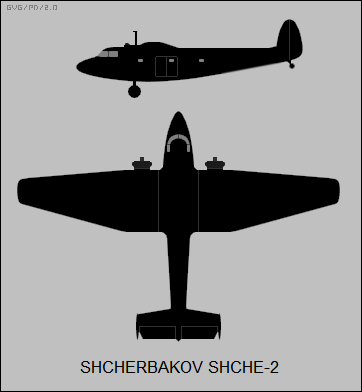
As it emerged, the Shche-2 was a high-wing aircraft featuring a twin tail, twin Shvetsov M-11d radials with 85 kW (115 HP) each -- cowled in the prototype, left bare in production -- and fixed taildragger landing gear. It was made largely of wood, possibly with some fabric used as well. It was elegant in appearance, with a fish-like fuselage and a broad strut-braced wing; although it was underpowered, its aerodynamic efficiency made it comfortable to fly, though its performance was modest and keeping it aloft with an engine out was difficult at best. The Soviets suffered from a small-engine gap, lacking a production radial with a power rating between the M-11 series and the ASh-21 series; it seems slightly puzzling as to why they didn't use a trimotor configuration, adding an M-11 engine in the nose.
The Shche-2 could carry up to 16 troops, 11 stretcher cases and a medical attendant, or up to 1,000 kilograms (2,200 pounds) of cargo loaded through a large door on the left side of the fuselage. It also could be used as a crew trainer. About 550 were built, the type proving very useful.
___________________________________________________________________
SHCHERBAKOV SHCHE-2:
___________________________________________________________________
wingspan:
20.54 meters (67 feet 5 inches)
wing area:
64 sq_meters (690 sq_feet)
length:
14.27 meters (46 feet 10 inches)
empty weight:
2,235 kilograms (4,927 pounds)
MTO weight:
3,700 kilograms (8,157 pounds)
max speed at altitude:
155 KPH (95 MPH / 85 KT)
service ceiling:
3,000 meters (9,850 feet)
range:
980 kilometers (610 MI / 530 NMI)
___________________________________________________________________
In 1945, an improved "Shche-2TM" was test-flown, this article featuring a modified wing and more powerful M-11FM engines with 110 kW (145 HP) each, but with the end of the war, there was no perceived need for it; another Shche-2 variant with diesel engines was also not followed up. Production of the Shche-2 ended in 1946, with the type laboring on for a few years in civil roles, until it was replaced by the Antonov An-2.
* Sources include:
Data on the Shche-2 was obtained from the online Wikipedia.
* Revision history:
v1.0.0 / 01 mar 13 v1.0.1 / 01 feb 15 / Review & polish. v1.0.2 / 01 jan 17 / Review & polish. v1.0.3 / 01 dec 18 / Review & polish. v1.0.4 / 01 oct 20 / Review & polish. v1.0.5 / 01 aug 22 / Review & polish. v1.0.6 / 01 jul 24 / Review & polish.BACK_TO_TOP
